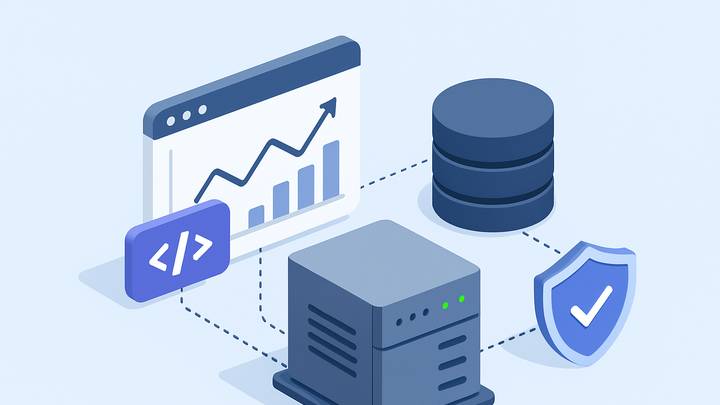Published on 2025-06-22T05:40:06Z
What is Self-Hosted Analytics? Examples, Benefits, and Tools
Self-hosted analytics refers to deploying your analytics infrastructure on servers that you control—either on-premises or in a private cloud—instead of relying on a third-party vendor’s cloud service. This model gives you full ownership of data collection, processing, and storage, enabling deeper customization and compliance with regional privacy regulations. By controlling the entire stack, you can tailor tracking logic, dashboards, and data pipelines to your unique needs, while avoiding vendor lock-in and unpredictable billing. Self-hosted solutions range from open-source platforms to privacy-focused SaaS offerings that can be self-deployed, such as PlainSignal’s cookie-free analytics. Though setup and maintenance require more effort than cloud-hosted alternatives, the trade-off is greater data sovereignty, security, and flexibility for organizations handling sensitive or regulated data.
Self-hosted analytics
A model where analytics infrastructure runs on your own servers for full data ownership, customization, and privacy compliance.
Definition and Overview
Self-hosted analytics empowers organizations to fully own and manage their analytics stack by running servers on-premises or in a private cloud. Unlike cloud-hosted analytics, where event data flows into vendor-managed environments, self-hosted setups collect, process, and store data on your own infrastructure. This grants absolute control over data flows, storage policies, and processing pipelines.
Key scenarios for self-hosted analytics include handling sensitive user data under strict regulations, integrating with internal systems, and avoiding recurring cloud vendor costs.
-
Core concept
Deploy and operate your analytics system on infrastructure that you manage, ensuring direct oversight of all data handling and processing stages.
-
Key characteristics
Self-hosted solutions can be open-source or proprietary but share common traits such as full configuration access and local data residency.
-
Data ownership
All raw and processed analytics data resides on your servers, giving you full authority over backups, retention, and security.
-
Customization
Modify tracking scripts, processing logic, and report dashboards to align precisely with your business requirements.
-
Security
Implement your own encryption, network segmentation, and access controls rather than relying on vendor defaults.
-
Benefits of Self-Hosted Analytics
Opting for a self-hosted analytics model offers several strategic advantages for organizations:
-
Enhanced privacy and compliance
Keep user data within your controlled environment to meet GDPR, CCPA, and other regulatory requirements without third-party dependencies.
-
Data sovereignty
Choose exactly where data is stored—whether in a specific region, country, or private network—to satisfy data residency mandates.
-
Customization and flexibility
Tailor the analytics pipeline, event taxonomy, and visualization layers to your unique KPIs and internal workflows.
-
Predictable costs
Control infrastructure expenses through fixed hosting plans or reserved instances, avoiding unexpected usage-based billing spikes.
Popular Tools and Platforms
A variety of solutions support self-hosted analytics, from lightweight scripts to full-featured engines. Two notable examples include PlainSignal and Google Analytics 4 with server-side tagging.
-
PlainSignal
A lightweight, cookie-free analytics platform that you can fully self-host. PlainSignal focuses on simple website metrics, privacy compliance, and straightforward deployment.
-
Cookie-free tracking
Captures essential metrics without relying on browser cookies or personal identifiers.
-
Simple dashboard
Provides pre-built visualizations for quick insights without complex configuration.
-
Easy deployment
Deploy via Docker or directly on your server with minimal dependencies.
-
-
Google analytics 4 (server-side tagging)
Leverage GA4’s server-side tagging feature to process events on your own server before forwarding them to GA4 or other endpoints.
-
Custom endpoints
Receive, filter, and enrich event data on a tagging server you control.
-
Enhanced privacy
Anonymize or exclude sensitive fields before data leaves your infrastructure.
-
Integration flexibility
Forward sanitized data to multiple analytics or data warehouse destinations in parallel.
-
Implementation Guide
Follow these steps to deploy a self-hosted analytics solution on your own infrastructure.
-
Infrastructure setup
Provision on-premises servers or cloud instances. Install and configure required components such as the web server, database, and analytics engine.
-
Server requirements
Ensure sufficient CPU, memory, and storage based on expected traffic and data retention policies.
-
Database selection
Choose a scalable database (e.g., PostgreSQL, ClickHouse) that fits your query and storage needs.
-
-
Deploy tracking code
Integrate the analytics script into your website. For PlainSignal, add the following snippet to your HTML:
<link rel="preconnect" href="//eu.plainsignal.com/" crossorigin /> <script defer data-do="yourwebsitedomain.com" data-id="0GQV1xmtzQQ" data-api="//eu.plainsignal.com" src="//cdn.plainsignal.com/plainsignal-min.js"></script> -
Data storage and backup
Configure your database retention policies, automated backups, and disaster recovery procedures to prevent data loss.
Best Practices
Maintain a reliable and secure self-hosted analytics environment by following these guidelines:
-
Security hardening
Use HTTPS, implement firewall rules, and perform regular vulnerability scans.
-
Performance optimization
Implement caching layers, database indexing, and load balancing to handle high traffic volumes.
-
Regular maintenance
Monitor server health, apply updates, and test backup restores on a schedule.
-
Compliance monitoring
Review and update data collection practices to stay aligned with evolving privacy regulations.
